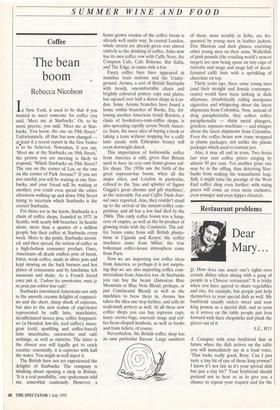Coffee
The bean
boom ,
Rebecca Nicolson
In New York, it used to be that if you wanted to meet someone for coffee you said, 'Meet me at Starbucks.' Or, to be more precise, you said, 'Meet me at Star- bucks. You know, the one on 59th Street.' Unfortunately, all that has now changed — atoleast if a recent report in the New Yorker is to be believed. Nowadays, if you say, `Meet me at the Starbucks on 59th Street,' the person you are meeting is likely to respond, 'Which Starbucks on 59th Street? The one on the corner of Lex, or the one on the corner of Park Avenue?' If you are not careful, you will be waiting at one Star- bucks, and your friend will be waiting at another; you could even spend the entire afternoon walking up and down 59th Street trying to ascertain which Starbucks is the correct Starbucks.
For those not in the know, Starbucks is a chain of coffee shops, founded in 1971 in Seattle, with nearly 600 branches. In Seattle alone, more than a quarter of a million people buy their coffee at Starbucks every week. More to the point, Starbucks invent- ed, and then spread, the notion of coffee as a high-fashion consumer product. Once, Americans all drank endless pots of burnt, bitter, weak coffee, made in silver pots and kept stewing on the back burners and hot plates of restaurants and by lunchtime felt nauseous and shaky. As a French friend once put it, Tadore les americains, mail je ne peu x pas tolerer leur café.'
Starbucks introduced Americans not only to the smooth, creamy delights of cappucci- no and the short, sharp shock of espresso, but also to the new realms of experience represented by caffe latte, macchiatto, decaffeinated mocca java, coffee frappucci- no (a blended, low-fat, iced coffee), maza- gran (cold, sparkling and coffee-based) latte macchiatto, cacaoccino and café mélange, as well as ristretto. The latter is the closest you will legally get to crack cocaine: essentially, it is espresso with half the water. You might as well inject it.
The British have not yet experienced the delights of Starbucks. The company is thinking about opening a shop in Britain. `It is a real possibility,' one spokesman told me, somewhat cautiously. However, a home-grown version of the coffee boom is already well under way. In central London, whole streets are already given over almost entirely to the drinking of coffee. Soho now has its own coffee row with Caffe Nero, the Compton Cafe, Cafe Boheme. Bar Italia, and The Edge, to name only a few.
Fancy coffee bars have appeared in mainline train stations and the Under- ground. Aroma, a sort of British Starbucks with trendy, uncomfortable chairs and brightly coloured pottery cups and plates, has opened over half a dozen shops in Lon- don. Some Aroma branches have found a home within branches of Books, Etc, fol- lowing another American trend: Borders, a chain of bookstores-cum-coffee shops, is also spreading rapidly across North Ameri- ca. Soon, the mere idea of buying a book or taking a train without stopping for a cafe latte (made with Ethiopian beans) will seem downright dated.
This importation of fashionable coffee from America is odd, given that Britain used to have its very own home-grown cof- fee shops. The 1950s saw the birth of the great espresso-bar boom, when all the major cities, and London in particular, echoed to the 'hiss and splutter of Signor Gaggia's great chrome and gilt machines', as the venerable Tea and Coffee Trade Jour- nal once reported. Alas, they couldn't stand up to the arrival of the instant-coffee com- petition, and all but a few had died by the 1960s. This early coffee boom was a hang- over of empire, as well as the by-product of growing trade with the Continent. The cof- fee beans came from still British planta- tions in Uganda and Kenya; the coffee machines came from Milan; the true bohemian coffee-house atmosphere came from Paris.
Now we are importing our coffee ideas from America, so perhaps it is not surpris- ing that we are also importing coffee com- mercialism from America too. At Starbucks you can buy the beans (Jamaican Blue Mountain or Blue Note Blend, perhaps, or just Continental Blend) as well as the machines to brew them in. Aroma has taken the idea one step further, and sells its trademark pottery as well. At all these new coffee shops you can buy espresso cups, fancy carrier-bags, souvenir mugs and cof- fee-bean-shaped bonbons, as well as books and train tickets, of course.
Nevertheless, the British coffee shop has its own particular flavour. Large numbers of them, most notably in Soho, are fre- quented by young men in leather jackets, Doc Martens and dark glasses, escorting other young men on their arms. Walletfuls of pink pounds (the retailing world's newest target) are now being spent on tiny cups of ristretto and mugs and mugs full of decaf- feinated caffe latte with a sprinkling of chocolate on top.
Thirty years ago, these same young men (and their straight and female contempo- raries) would have been lurking in dark alleyways, ritualistically rolling marijuana cigarettes and whispering about the latest shipments from Colombia. Now, instead of drug paraphernalia, they collect coffee paraphernalia — shiny metal plungers, grinders, espresso machines — and whisper about the latest shipments from Colombia. Even the coffee beans now come wrapped in plastic packages, not unlike the plastic packages which used to contain pot.
Alas, it may all end in tears. Two frosts last year sent coffee prices surging by almost 90 per cent. Yet another price rise may be in the offing, thus deterring Star- bucks from making the transatlantic leap. Still, it might raise the prestige of the West End coffee shop even further: with rising prices will come an even more exclusive, even younger and even hipper clientele.


































































 Previous page
Previous page